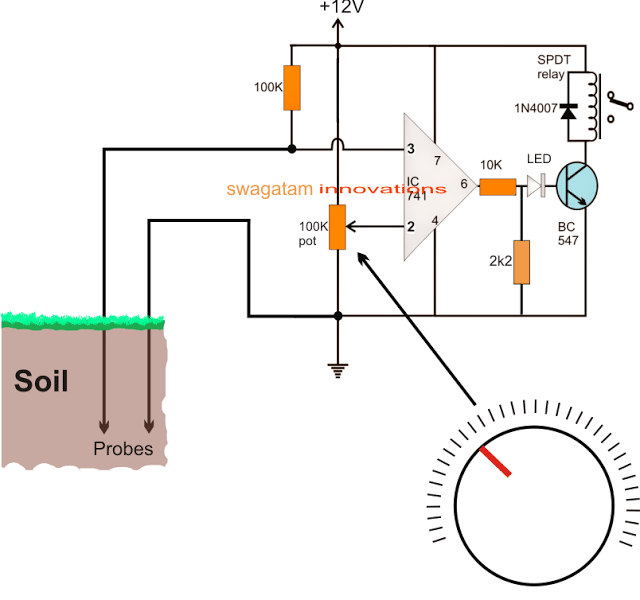A very simple mud or soil moisture tester circuit can be built by using a single opamp and a few passive components, I have explained the details through the following article.
Circuit Objective
After water and sunlight the earth or the soil is the next most important natural gift that this planet has provided us with, without which persisting of the living beings could never be possible.
Soil produces plants, and plants supply us food. However plants need a well watered soil, or in other words plants or crops cannot survive without an optimal supply of water to the soil in which they grow.
Therefore testing the correct soil moisture becomes a crucial aspect in order to cultivate healthy crops without wasting excess water.
A simple soil moisture tester circuit explained can be used by anybody who may be interested to check or monitor the moisture level of a given area of land and ensure the correct amount of water supply to it, either manually or automatically through the same circuit.
So we have both the options available with this circuit, it enables the user to test the level of moisture of the soil, and if required make the unit an automatic soil moisture level controller by connecting a motor pump with the attached relay contacts in the circuit.
Circuit Operation
Let's see how the circuit is designed to function:
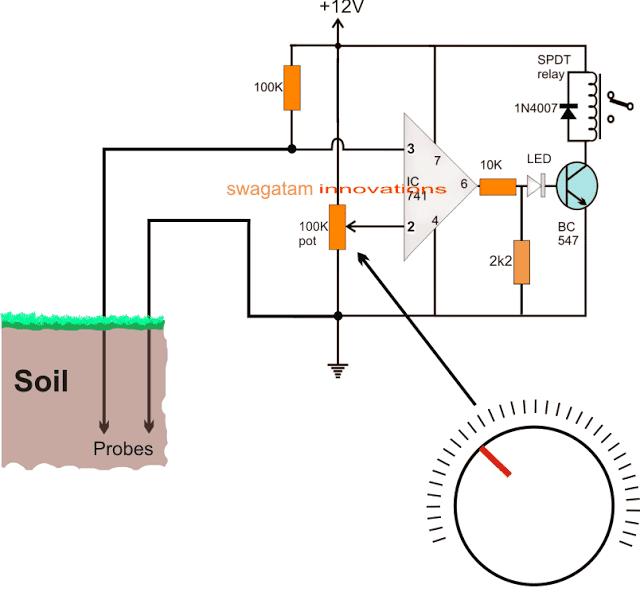
Referring to the circuit above, the design makes use of a single IC 741 opamp comparator for the required testing function.
The pin3 which is the non-inverting input of the opamp is used as the main sensor probe with respect to the other probe connected with the ground.
The moisture level present in the soil develops a resistance across it which increases with a decrease in the moisture level and decreases with an increase in the moisture level, meaning a wet soil will have a much lower resistance compared to a dryer soil.
This aspect is exploited in the design the probes are used to test the soil resistance between pin#3 and ground of the comparator IC 741.
This soil resistance forms a potential divider with the 100K resistor connected across the positive supply line and pin#3 of the IC, and the potential difference developed here in response to the soil moisture level is compared by the potential at pin#2.
Pin#2 potential is determined by the setting the shown 100k pot. Thus this pot is effectively used for determining or verifying the exact moisture present in the soil.
If the soil moisture produces a lower resistance at pin#3 than the set level at pin#2, the output at pin#6 is rendered low, meaning when the soil is relatively wet the output of the opamp shows a zero volt, while in case the soil condition develops a higher resistance (dry condition) then the output of the opamp goes positive, triggering the connected transistor and the relay.
In other words, the output of the opamp and the relay stay switched OFF as long as as the soil moisture level is more than the threshold set by the pin#2 pot, and vice versa. Therefore a relatively wet soil will keep the relay switched OFF, and a dry soil will switch it ON.
The LED complements the relay action and illuminates whenever the soil is dry than the desired set level.
This pot needs to be appropriately calibrated with a dial and then the various points across the dial marked as per the predetermined moisture content of a sample soil collected inside a container.
Once this is done, the calibrated pot can be used for checking any soil by simply inserting the shown probes into the soil, and by adjusting the pot until the output is rendered a high (LED ON).
How to use the Circuit as a Soil Moisture Controller
As explained above, once the pot is set to a desired value, whenever the soil moisture goes below this set level, the relay is instantly activated.
In the switched ON position the relay contacts join the N/O contacts, and these contacts could be wired to a water pump and its power supply in series, so that whenever the relay clicks, the motor pump is activated and the soil begins getting the required water supply until its moisture level is restored to the desired optimal point.
At this level the opamp detects the condition and quickly changes over to a zero logic at its output, switching OFF the relay and the motor, the water spraying is consequently stopped.
The above action keeps repeating by testing the soil moisture and applying water accordingly, in an entirely automated way without any manual intervention.
Using Iron Nails as Probes
For the sensor probes you can simply use a pair of good quality galvanized iron nails which can be around 6 inches long, as shown in the following image. Solder the sensor wires from the op amp circuit with the nails and push the nails at least 5 inches deep inside the soil. Make sure the distance between the probes is not more than 3 inches wide, inside the soil.
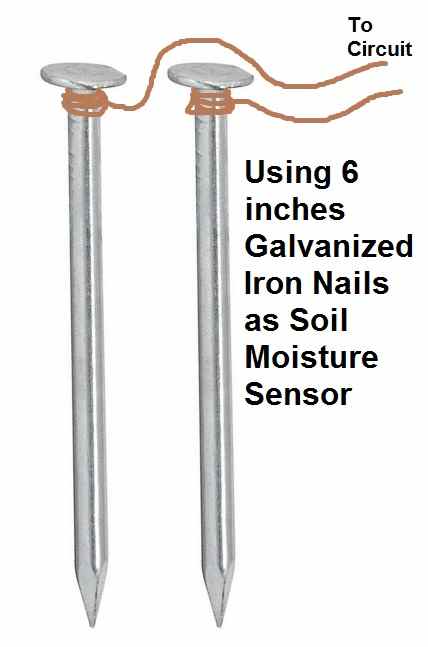
Moisture Sensor using Copper/Zinc Mesh which works like Electricity Generator
The idea was suggested by one of the avid readers of this blog, Mr. Doug:
I have what I suspect is an impossible circuit, but want to run it pass you to confirm.
I am sure you have knowledge of a simple moisture tester. This device uses dissimilar metals generally made up of copper and zinc. These metals when exposed to moisture (water) give a very low electrical current, this is the basis of my question:
I would like to know if there is any circuit and or device that could be powered by say a 3.7vdc lithium Ion battery or a 1.5VDC AAA battery that is basically in the off position, until two leads senses moisture, thereby powering up and indicating by a low volt LED that there is moisture across these 2 “LEADS” dissimilar metals but wouldn’t cause any, “shock” if applied to sensitive skin?
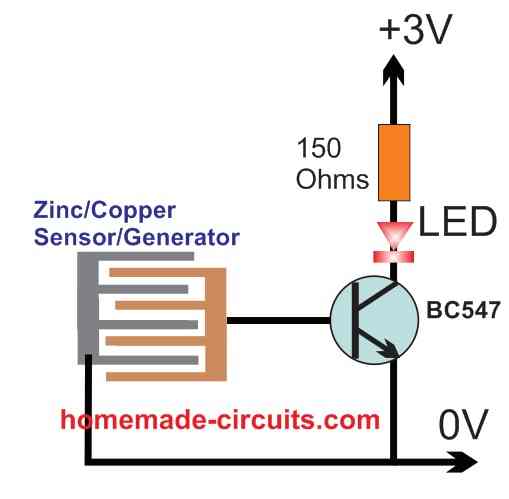
Soil Moisture Sensor with Motor Pump Control
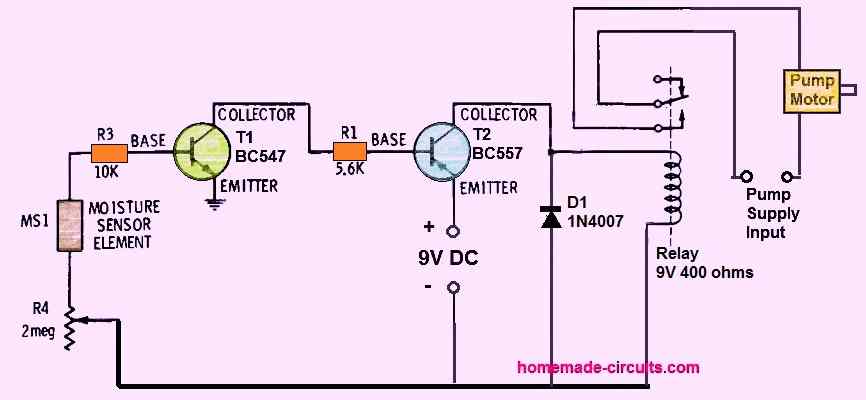
The previous circuit using a single BC547 can be further upgraded into a soil moisture controller circuit with motor pump.
The moisture element can be the same as used in the earlier diagram, consisting of zinc/copper tracks held very close to each other.
As long as there's no moisture in the soil, or the soil is dry, no voltage is fed to the base of the BC547.
Due to this both the transistors are switched OFF, causing the relay to remain switched OFF.
Since the motor pump is connected across the N/C contacts of the motor, the motor pump remains switch ON, so that water can be released into the soil.
When moisture or water droplets is detected across the moisture sensing element, tiny electrical potential is generated across the sensor terminals.
This tiny potential difference is sufficient to trigger ON the BC547 transistor which in turn causes the BC557 to switch ON hard.
The BC557 now turns the relay contacts OFF, which was normally switched ON due to a dry moisture sensor detection.
The relay contacts switch OFF the motor pump. The pump remains OFF as long as the moisture sensor does not become dry again.
The moisture sensor can be inserted deep into the soil whose moisture content needs to be sensed and controlled through the motor pump water.
The pot R4 can be used to adjust the sensitivity of the moisture sensor element.
